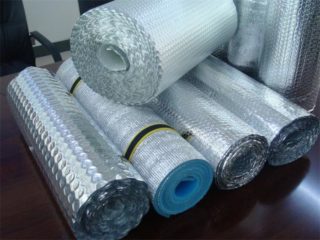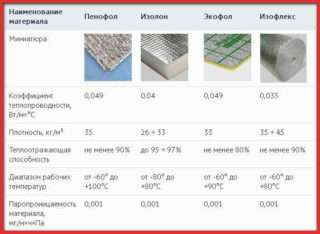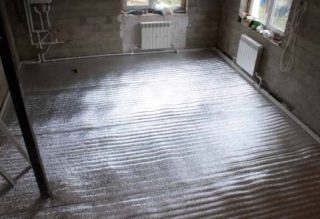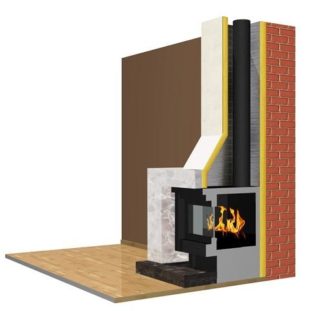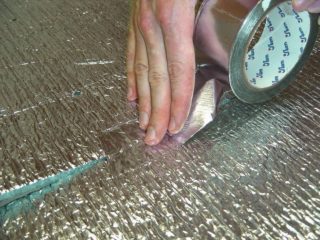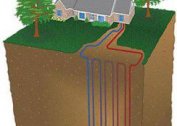Stricter requirements for the quality of construction and insulation of buildings, as well as the improvement of insulation production technologies, allowed the launch of a number of new materials with improved characteristics. Among them - foil insulation, the numerous advantages of which provide high-quality thermal insulation of structures for various purposes. Due to the reasonable cost and ease of installation, the material is in high demand and is used where it is necessary to reduce the time for finishing work.
Description and features of foil insulation
For a long time, the only insulation that had no analogues was mineral wool. Specialists performing decoration and repair had to put up with its many shortcomings or look for ways to eliminate them. A short contact with water was enough for the mineral wool insulation layer to lose some of its useful characteristics. In addition, prolonged work with such isolation could harm the health of the craftsmen due to the specific structure.
The abandonment of the use of mineral wool was allowed by the release of foil insulation. This is a two-layer material in the form of plates or sheets, one surface of which is reinforced with a thin layer of foil. Insulators with outstanding insulating characteristics act as a basis: penofol, polystyrene foam, polystyrene and other materials with a foamed structure. Sometimes foil insulation is called the same as its base. But all these additional names are united by a single structure and approximately the same properties.
The presence of heat-insulating foil allows the material to reflect the absorbed thermal energy and direct it back into the room, thereby reducing possible heat loss to a minimum and reducing the cost of heating the premises. In addition, the foil does not absorb water and does not get wet, which eliminates damage to the main layer of insulation. Depending on the purpose, the sheets have different thicknesses and pore sizes, on which the thermal insulation parameters depend.
Advantages and disadvantages
The popularity of foil insulation led to the following advantages:
- outstanding insulating properties, allowing to rely on high-quality and durable insulation;
- high rates of noise isolation, eliminating the penetration of extraneous sounds from the street into the room;
- climatic resistance, ability to withstand sudden changes in temperature;
- pronounced vapor barrier characteristics;
- zero hygroscopicity, protection of the interior of the house from high humidity and dampness.
The insulation with foil has no restrictions on the scope, largely due to its environmental safety for humans. It is allowed to use such isolation in children's rooms, in medical, social and educational institutions.
Foil roll insulation based on penofol or expanded polystyrene has special strength characteristics. Its ability to withstand significant mechanical stress allows the use of insulation for flooring in rooms with high traffic or heavy furniture.Due to climate resistance, foil insulation can be used in the arrangement of a system of underfloor heating. It will provide an additional reduction in heat loss and the penetration of cold air into the room from the street. The cost of buying and installing insulation will pay off many times due to reduced heating costs and the ability to abandon the operation of additional heating appliances.
Another important advantage of foil insulation is the ease of installation, which even a beginner can handle. Sheets and roll fragments are easily cut and fixed using conventional tools. You should not save on the purchase of insulation, especially since its cost is quite affordable, and the operational characteristics do not deteriorate even after prolonged use.
Thermal insulation with foil is more expensive than similar materials without a protective layer. The difference in price is due to the cost of manufacturing and laying metal sheets on the sheets. However, the additional costs of purchasing foil material are fully justified by the consumer properties of the material, several times higher than the similar parameters of heaters without foil.
Application area
Reflective insulation is used in the decoration of any type of indoor surfaces: walls, roofs, floors, ceilings, partitions, ceilings, etc. Its use allows us to solve the following issues:
- increase the efficiency of the underfloor heating system;
- to exclude the penetration of cold into the house from the basement;
- to achieve reliable thermal insulation of walls and floors;
- insulate the roof and roof space;
- equip a glazed balcony, loggia or veranda;
- protect pipes and communications from exposure to wet soil and freezing temperatures;
- to insulate the premises of swimming pools, baths and saunas, where it is necessary to ensure the preservation of the maximum amount of heat and reduce its loss.
The appropriate type of material is selected depending on the thickness, purpose and insulation characteristics. A prerequisite for high-quality insulation of the building is the use of foil material on the first floors, where it is important to provide reliable protection from cold and soil moisture.
The main types of foil insulation
The characteristics of various types of insulating materials are significantly different and depend on the properties of the substrate. This allows you to choose a heater depending on the specific type of room, its actual and desired microclimatic conditions, operating characteristics and other factors. Also important are the properties of a brilliant insulation: its thermal conductivity, life, elasticity, mechanical strength and resistance to deformation.
Currently, the assortment of insulation materials includes:
- Styrofoam. Volumetric and thick sheets with pronounced insulating characteristics. Production technology involves the melting of polystyrene granules and their formation into a material with a single structure. Among the advantages are a high degree of strength, biological resistance, and a long service life. Foamed polystyrene foam protects properties in a wide temperature range from -180С to + 180С. Scope - floor insulation and water heating systems, where mechanical impact on the insulation and operation in high humidity conditions is likely.
- The made foam polyethylene. Roll insulation with a foil layer on one or two sides. Basis - materials penofol, ecofol, isolon and other heaters of the latest generation. Thickness within 2-10 cm, thermal conductivity of about 0.038 W / (mK).An adhesive layer on one of the surfaces simplifies and speeds up the laying of the material. Scope - insulation of floors, walls, utilities: ventilation, sewage, etc.
- Mineral wool. Insulation with severe restrictions on use due to the release of phenol into the air. It is recommended for use in non-residential premises, provided that the surface protective layer is made of a dense film. It is realized in the form of plates or rolls. A scope - thermal insulation of balconies, roofs and floors in auxiliary rooms. The material is available in thicknesses of 5 to 10 cm.
- Basalt insulation. Mineral wool based material. It is characterized by climatic resistance, able to withstand a significant increase in ambient temperature up to +700 C. It can be used to equip stoves and fireplaces, roofs and walls, floors, etc.
Less commonly used is heat-reflecting material based on foam sheets, one side of which is glued with foil. It is used to equip the foundation in the construction of buildings and structures from scratch. Another relatively rare material is a polypropylene film with metal inclusions, due to which thermal energy is evenly distributed over the surface of the finish and stored for a long time.
Features of installation work on laying insulation
Laying sheets of foil insulation is carried out using:
- stapler;
- nails with large hats;
- construction tape.
The installation of reflective insulation is carried out with the foil side up. Otherwise, the insulating layer will be completely useless, it will not be possible to reduce heat loss with its help. Experts recommend leaving a small air gap between the insulation and the floor covering, due to which it is possible to increase the level of floor insulation.
Laying insulation for the walls inside the house with an overlap foil is not allowed. Sheets are mounted butt-to-butt and fixed with nails or tape, depending on the thickness of the substrate. A material with an adhesive composition also requires additional fixation at the edges. After laying, the joints are additionally glued with tape. If the insulation is recessed in a concrete screed, there is no need for its waterproofing. For other coatings it is recommended to additionally protect the insulation from high humidity.
The sequence of laying foil insulation:
- the surface is cleaned of debris and dried;
- the insulation is cut into fragments of the desired size and leveled on a flat surface;
- sheets are fixed along the walls and further across with the help of wooden bars;
- over the insulation, a crate is laid, due to which an air gap forms between the insulation and the coating;
- the floor is covered with a coating or poured with concrete screed;
- if the installation of a system of underfloor heating is provided, the work is performed at the final stage.
Compliance with the recommendations for laying foil insulation is the only way to preserve the useful properties of the material and evaluate them in practice. You can clarify the installation features according to the instructions that accompany each of the proposed materials.
